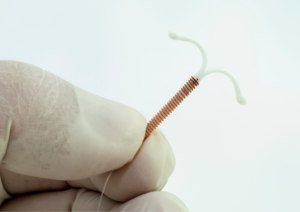Are you considering a reliable and hormone-free birth control option? The copper IUD might just be what you’re looking for. This small, T-shaped, hormone-free IUD for contraception offers a host of benefits, including long-lasting protection against unintended pregnancy for up to ten years. Yet, despite its growing popularity, many myths and misconceptions surround the copper IUD. In this comprehensive guide, we’ll delve into everything you need to know about the copper IUD—from its incredible benefits to address common myths you might have encountered. Whether you’re seeking information for yourself or supporting someone else, we aim to demystify this effective contraceptive method. Join us as we uncover the facts and provide answers to frequently asked questions, ensuring you have the knowledge necessary to make informed decisions about your reproductive health.
How the Copper IUD Works

The copper intrauterine device (IUD) is a small, T-shaped piece of flexible plastic wrapped with copper wire that is inserted into the uterus by a healthcare professional. The primary mechanism of this hormone-free IUD for contraception by which the copper IUD prevents pregnancy is through the release of copper ions into the uterine environment. These ions create an inhospitable environment for sperm, effectively reducing their motility and viability, which prevents them from fertilising an egg. Additionally, the presence of the copper IUD induces a local inflammatory reaction in the endometrium, further contributing to its contraceptive efficacy.
Unlike hormonal birth control methods, the copper IUD is a hormone-free IUD and does not rely on the release of synthetic hormones to prevent pregnancy. This makes it an attractive option for individuals who prefer a hormone-free contraceptive method. The copper IUD’s effectiveness is comparable to hormonal IUDs and other long-acting reversible contraceptives (LARCs), boasting a failure rate of less than 1% with typical use. This high level of effectiveness is consistent over a period of up to ten years, making it a long-term and low-maintenance option for many.
The copper IUD begins working immediately upon insertion, making it a convenient choice for those who need immediate contraception. Furthermore, it can also be used as emergency contraception if inserted within five days of unprotected intercourse. This dual function adds to its versatility and appeal, providing both ongoing and situational protection against unintended pregnancy.
Benefits of the Copper IUD
One of the most significant benefits of the copper IUD is its longevity. Once inserted, it can provide effective contraception for up to ten years without the need for daily attention or frequent medical appointments. This long-term protection is ideal for individuals who wish to avoid the hassle of remembering to take a daily pill or replacing a contraceptive method frequently. The copper IUD’s “set it and forget it” nature allows users to focus on other aspects of their lives without worrying about unintended pregnancy.
For those concerned about the potential side effects of hormonal contraceptives, the copper IUD offers a hormone-free alternative. Hormonal contraceptives can sometimes cause side effects such as weight gain, mood swings, and decreased libido. The copper IUD avoids these issues entirely, as it does not alter the body’s natural hormonal balance. This makes it a suitable option for individuals who have experienced adverse reactions to hormonal methods or who prefer to avoid hormones altogether.
Another notable benefit is the copper IUD’s immediate return to fertility upon removal. Unlike some hormonal methods, which can delay the return of normal ovulation and menstrual cycles, fertility typically resumes right away after the copper IUD is taken out. This makes it an excellent choice for individuals who may want to conceive soon after discontinuing contraception. Additionally, the copper IUD has no long-term impact on fertility, ensuring that it remains a reversible and flexible option for family planning.
Common Myths About the Copper IUD
Despite its numerous benefits, several myths and misconceptions persist about the copper IUD. One common myth is that the insertion process is extremely painful. While some discomfort is normal during the procedure, the pain is typically brief and manageable with over-the-counter pain relief. Additionally, healthcare providers can offer strategies to minimize discomfort, such as using a local anaesthetic or recommending relaxation techniques.
Another myth is that the copper IUD can cause significant weight gain. This misconception likely stems from experiences with hormonal contraceptives, which can sometimes lead to weight changes. However, because the copper IUD is a hormone-free IUD, it does not cause weight gain. Any fluctuations in weight experienced while using the copper IUD are likely due to other factors, such as diet, exercise, or natural body changes.
Some people believe that the copper IUD increases the risk of pelvic inflammatory disease (PID). While there is a slightly elevated risk of infection immediately following insertion, this risk is minimal and decreases significantly after the first few weeks. The risk of developing PID due to an IUD is comparable to that of the general population. Ensuring that the insertion is performed by a trained healthcare professional and following post-insertion care instructions can further minimize this risk.
Comparing the Copper IUD to Other Contraceptive Methods
When considering the copper IUD, it’s essential to compare it to other available contraceptive methods to determine the best fit for your lifestyle and health needs. Oral contraceptive pills, for instance, require daily adherence and can be less effective if not taken consistently at the same time each day. In contrast, the copper IUD eliminates the need for daily action, offering a worry-free alternative.
Hormonal IUDs, like the Mirena or Kyleena, (https://healthyhavenfamilyclinic.com.au/services/womens-health/mirena-insertion-and-removal/) also provide long-term contraception but release hormones that can cause side effects in some users. While both hormonal and copper IUDs are highly effective, the choice between them often comes down to personal preference regarding hormone exposure. Some individuals may find the hormone-related side effects of hormonal IUDs, such as mood changes or irregular bleeding, undesirable, making the copper IUD a preferable option.
Barrier methods, such as condoms and diaphragms, offer protection against sexually transmitted infections (STIs) in addition to preventing pregnancy. However, their effectiveness depends on correct and consistent use every time intercourse occurs. The copper IUD, while not providing STI protection, ensures a high level of pregnancy prevention without the need for user intervention once inserted. This makes it a highly reliable option for those looking for a set-and-forget method.
Hormone-free IUD for contraception
Side Effects and Risks of theCopper IUD
Like any medical device, the copper IUD comes with potential side effects and risks that users should be aware of. One of the most commonly reported side effects is increased menstrual bleeding and cramping, particularly in the first few months following insertion. While this can be bothersome for some, it often diminishes over time as the body adjusts to the IUD. Over-the-counter pain relievers and anti-inflammatory medications can help manage these symptoms.
Another potential risk is the expulsion of the IUD, where the device partially or completely falls out of the uterus. This is relatively rare, occurring in about 2-10% of users, and is more likely to happen in the first year of use. Regular check-ups with a healthcare provider can help ensure the IUD remains in place. If expulsion occurs, it’s important to use an alternative contraceptive method until the IUD can be reinserted or replaced.
In rare cases, the IUD can perforate the uterine wall during insertion. This risk is minimal but should be discussed with your healthcare provider. If perforation occurs, the IUD may need to be surgically removed. It’s also essential to note that while the copper IUD is highly effective at preventing pregnancy, it does not protect against STIs. Using condoms in conjunction with the IUD can provide additional protection against infections.
Who Should Consider the Copper IUD?
The copper IUD is a suitable contraceptive option for a wide range of individuals, particularly those seeking a long-term, hormone-free method. It’s an excellent choice for people who have experienced adverse reactions to hormonal contraceptives or prefer to avoid hormones due to personal or medical reasons. Its effectiveness and longevity make it a highly convenient option for those with busy lifestyles who may have difficulty adhering to daily or monthly contraceptive routines.
Individuals who need immediate contraception or emergency contraception may also benefit from the copper IUD. Its ability to provide immediate protection upon insertion makes it a practical choice for those who need quick and reliable contraception. Additionally, those looking to maintain their fertility and plan for future pregnancies may find the copper IUD appealing due to its reversible nature and the swift return of fertility upon removal.
However, the copper IUD may not be suitable for everyone. Individuals with a known allergy to copper, those with certain uterine abnormalities, or those with active pelvic infections should discuss alternative contraceptive options with their healthcare provider. A thorough medical evaluation and consultation can help determine if the copper IUD is the right choice based on individual health needs and lifestyle.
Insertion Process: What to Expect
The insertion process for the copper IUD is a straightforward procedure that typically takes place in a healthcare provider’s office. Before the insertion, your provider will conduct a pelvic exam to assess the position and size of your uterus. This ensures the IUD can be placed correctly and comfortably. You may be advised to take over-the-counter pain relievers before the appointment to help manage any discomfort during the procedure.
During the insertion, you will lie on an exam table similar to a gynaecological exam. A speculum is used to hold the vaginal walls open, and the healthcare provider will clean the cervix and surrounding area with an antiseptic solution. The IUD is then inserted through the cervix into the uterus using a thin, flexible tube known as an inserter. The arms of the IUD will open into the T-shape once inside the uterus. The entire process usually takes just a few minutes.
After the insertion, you may experience some cramping and spotting, which is normal and typically subsides within a few days. It’s essential to follow any post-insertion care instructions provided by your healthcare provider, such as avoiding intercourse or tampon use for a specified period. A follow-up appointment may be scheduled to ensure the IUD is correctly positioned and to address any concerns. Regular self-checks of the IUD strings can help ensure it remains in place.
Frequently Asked Questions About the Copper IUD
Q: How effective is the copper IUD at preventing pregnancy?
A: The copper IUD is over 99% effective at preventing pregnancy, making it one of the most reliable contraceptive methods available. Its effectiveness remains consistent for up to ten years.
Q: Can the copper IUD be used as emergency contraception?
A: Yes, the copper IUD can be used as emergency contraception if inserted within five days of unprotected intercourse. It is highly effective in preventing pregnancy when used in this manner.
Q: Will the copper IUD affect my menstrual cycle?
A: The copper IUD can affect menstrual bleeding patterns, particularly in the first few months after insertion. Users may experience heavier and longer periods, as well as increased cramping. These symptoms often improve over time.
Q: Can I use tampons with the copper IUD?
A: Yes, you can use tampons with the copper IUD. However, it is generally recommended to avoid tampon use for the first 24 hours after insertion to reduce the risk of infection.
Q: How is the copper IUD removed?
A: The removal of the copper IUD is a simple procedure performed by a healthcare provider. The provider will gently pull on the IUD strings to remove the device from the uterus. The process is usually quick and causes minimal discomfort.
Q: Can the copper IUD move or become dislodged?
A: While rare, the copper IUD can move or become dislodged, especially within the first year of use. Regular self-checks of the IUD strings and follow-up appointments with your healthcare provider can help ensure it remains in place.
Q: Do you insert copper IUDs at Healthy Haven Family Clinic?
A: Yes, Dr Orit Abdalla is an accredited IUD provider. She completed her training at Sexual Health Victoria. You can find her on the IUD provider list at: https://shvic.org.au/professional-learning-support/clinical-support/iud-provider-list
Conclusion: Is the Copper IUD Right for You?
Deciding on a contraceptive method is a personal choice that should be guided by your individual health needs, lifestyle, and preferences. The copper IUD offers a highly effective, long-term, and hormone-free option for those seeking reliable birth control. Its benefits, such as immediate effectiveness, longevity, and the absence of hormones, make it an attractive choice for many. However, it’s essential to consider the potential side effects, such as increased menstrual bleeding and cramping, and to discuss any concerns with your healthcare provider.
Understanding the facts about the copper IUD, including how it works, its benefits, and addressing common myths, can help you make an informed decision. Whether you’re considering the copper IUD for its long-term protection, its hormone-free nature, or its suitability as emergency contraception, it remains a versatile and effective option for many.
Ultimately, the best contraceptive method is one that aligns with your health needs and lifestyle. By consulting with your healthcare provider and considering all available information, you can determine if the copper IUD is the right choice for you. Knowledge empowers you to make decisions that support your reproductive health and overall well-being. For more information on Copper IUDs, visit: https://shvic.org.au/for-you/contraception/iud-intrauterine-device/copper-iud
Hormone-free IUD for contraception



